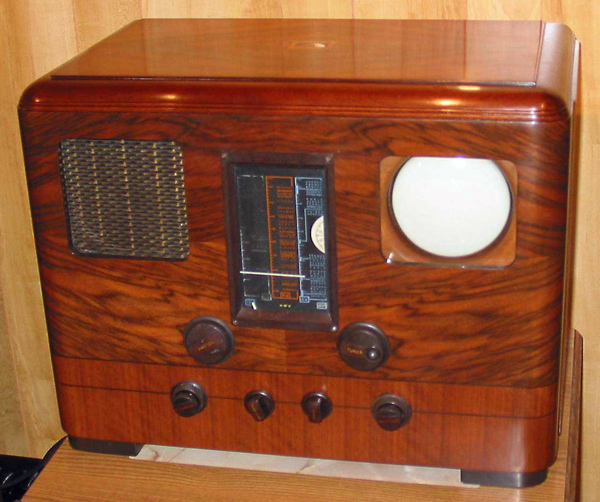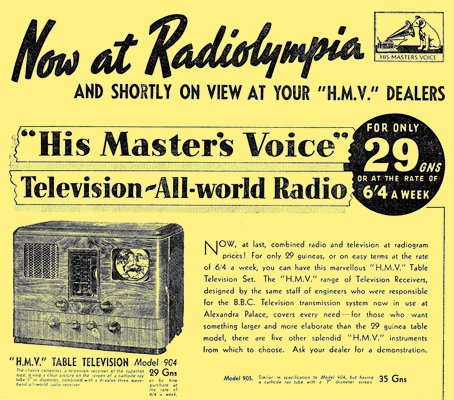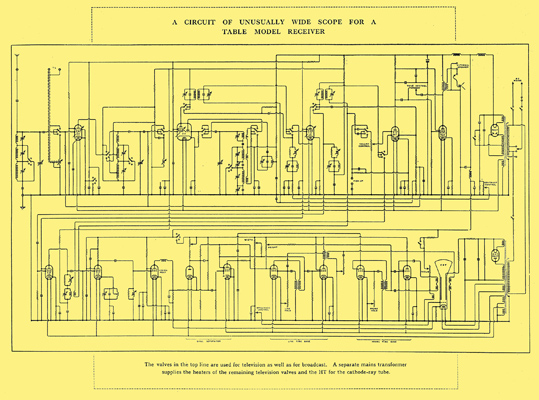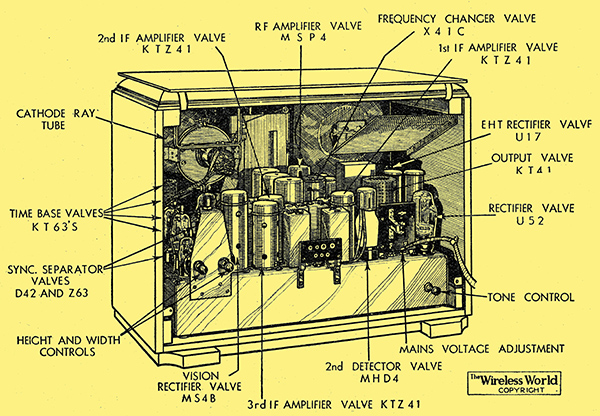|
A Receiver for Television and All-wave Broadcast Reception at 29 Guineas.

Features: Wave-ranges.-(1) Fixed tuning for Alexandra Palace, vision (41 MHz) and sound (41.5 MHz). (2) 16.5-50 metres. (3) 200-520 metres. (4) 725-2,000 metres. Circuit: (Television and Broadcast) Pentode RF amp, triode hexode frequency changer, tetrode IF amp, double diode triode 2nd det, tetrode output valve. Full wave rectifier. (Supplementary television stages). Tetrode 2nd IF amp, tetrode 3rd IF amp, tetrode anode bend 2nd det, sync separator (diode and pentode), two tetrode (triode connected), frame time base valves, two tetrode line time base valves Half-wave EHT rectifier. Controls: (Broadcast) (1) Tuning (2) Volume and on-off switch (3) Wave-change television and gram switch (4) Tone (Television) (1) Focus (2) Brilliance (3) Line hold (4) Frame hold (5) Height (6) Width. Price: 29 guineas. Makers. The Gramophone Co., Ltd., 98-108, Clerkenwell Road, London, EC1.
For every present owner of a television receiver there must be a hundred who have privately resolved or publicly asserted that they would acquire one as soon as the price came down to that of a good table model receiver. The Gramophone Company now offers the means of redeeming that promise; it goes further and includes the good table model receiver in the bargain.

Advertisement placed inside front cover of the issue.
The 5-inch tube may at first sight appear small, but so do the 10 inch tubes of more expensive sets when compared with 16 mm home cinema pictures, and the latter by comparison with the public cinema screen. Fortunately the eye is as accommodating as the ear has shown itself to be when listening to the full orchestra through a small loud speaker provided the matter is sufficiently interesting one soon forgets the limitations. of the medium. Arguing on these lines we might say that a still smaller picture would suffice, but the present vogue for miniature cameras and the manner of their use supplies the right answer. No one thinks of showing direct prints from these postage stamp negatives but everyone is satisfied with a 'big print' measuring 4¼ × 3¼ inch and a post card enlargement is regarded as something of a luxury as far as comfort of viewing is concerned. A post card placed over the screen of the Model 904 leaves a good deal of the height of the picture uncovered and only just overlaps the length.
None of the essential controls of picture size, shape or quality has been omitted to cheapen the receiver. Consequently it was easy to ascertain that whereas a rectangular picture with the corners touching the edge of the tube was too small, a picture nearly filling the end of the tube with portions of the edges barely showing was just right.
The ratio of width to height having been adjusted by means of the auxiliary controls at the back of the set, all other qualities of the picture are taken care of by the controls on the front panel. The settings of the concentric frame and line hold controls are by no means critical and should present no difficulty to a beginner once he has learned to distinguish the effects of wrong adjustment in each case. It was also gratifying to find that alteration of the height and width controls had very much less than the usual effect on synchronisation. Contrast and brilliancy controls are also arranged concentrically and an ample range is provided to give the best possible compromise for viewing either in moderate light or in complete darkness.
Focusing is sharp and the drift due to warming of the magnet coils is small. Attention to this control is not called for more than twice during an hour's transmission. Definition is excellent and the bandwidth of the amplifiers appears to be exactly right having regard to the size of the picture. The curvature of the end of the tube is designed to give clear vision over an angle of about 120 ° and with normal eyesight one can enjoy the programme at any distance from one to five feet.
Care is necessary in the choice of a suitable aerial. This point was emphasised when the receiver was tried first with a dipole with reflector (not HMV) which showed some discrimination against the sound and called for a setting of the contrast (RF gain) control which gave too hard a picture when adequate volume was reached.

Circuit of the 904.
Sound and vision signals are amplified simultaneously by the earlier stages of the broadcast. section of the receiver, the response being broad enough to cover both bands. The IF amplifier in the main broadcast receiver has tuned anode circuits in series for the vision and sound beat frequencies, and its output is passed to a separate television IF amplifier. The sound signals are taken by a coupling coil to the sound detector and output stages of the broadcast receiver, and the vision frequencies are again tuned-anode coupled to a third IF amplifier with negative feedback for vision only.
Anode Bend Vision Rectifier
The vision rectifier is an anode bend detector and as the output is negative for signals corresponding to white the connections to the grid and cathode of the CR tube are the reverse of those used in the case of a diode.
A diode across part of the anode load of the vision rectifier acts as sync separator in association with a pentode amplifying and phase reversing valve. The frame pulses are taken from the anode through a suitable integrating circuit and the line pulses are derived from the screen.
The time bases are of the hard valve type with oscillators and associated amplifiers designed to give a linear sweep with the required voltage output in association with the magnetic deflecting coils. Tetrodes connected as triodes are used for the frame and tetrodes for the line.
A separated mains transformer and half-wave rectifier supplies the extra high-tension for the anode system of the tube. The heater current for those valves which are devoted entirely to television is also taken from this transformer which is switched on when the wave-range switch is turned to the television position. When receiving television the mains consumption is of the order of 200 Watts, and for normal broadcast reception this is reduced to 85 Watts.
The performance of the broadcast receiver section of the Model 904 was better even than we expected it to be. Selectivity that gives clear reception of the Deutsch-landsender on long waves, and no interference outside one channel on either side of London Regional at a distance of 15 miles is backed by a high degree of sensitivity which is well maintained to the extremes of the medium- and long-wave ranges. The short-wave range was particularly good, and we have seldom heard as good a signal-to-noise ratio, even in a set with a tuned RF stage. Working by the feel of the controls and the general level of background noise one is apt to have the volume up much too far until a signal is received, when the sensitivity will at once be obvious. This RF stage is undoubtedly pulling its weight, not only as regards signal-to-noise ratio, but also in suppressing second channel interference which could not be detected by the presence of repeat points.
The loud speaker gives a remarkable performance for its size which has been governed apparently by considerations of cabinet symmetry. The bass is all that one could wish from a table model, and the small diaphragm is well able to do justice to the extended frequency range available on the television sound channel. If the response is a little too crisp and hard for some types of transmission, there is a tone control at the back of the chassis which cuts top and incidentally volume as well if used too drastically.
The same receiver equipped with a 7-inch tube (Model 905) giving an effective picture size of 6¼ × 5 inches41- inches is available for 35 guineas, and an instrument table designed to match either model can be obtained for 3 guineas extra.

By giving close attention to screening, the fifteen valves have been assembled in a single compact chassis. The Television tube is on the left and its focus and deflection coils are also screened.
|